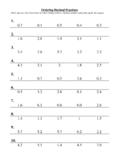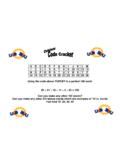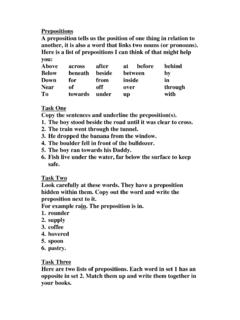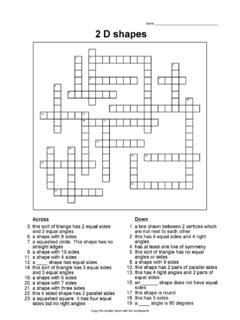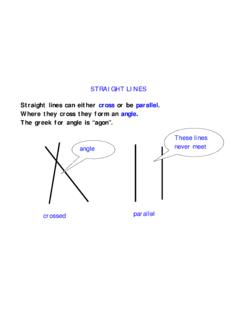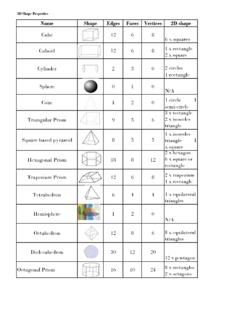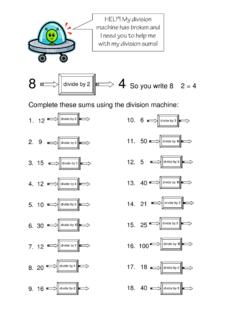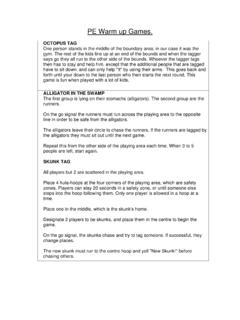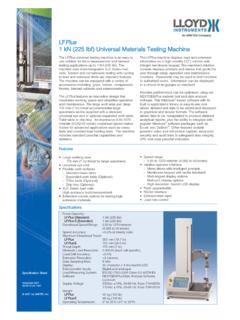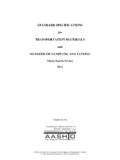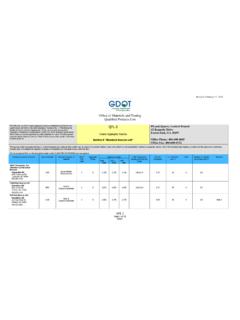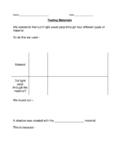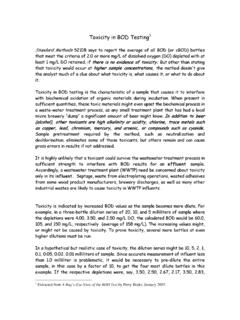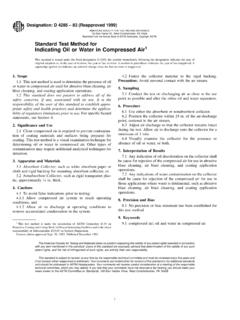Transcription of THE PROPERTIES OF MATERIALS and their everyday uses
1 11 Science background for teachersTHE PROPERTIES OF MATERIALSand their everyday usesChildren need to have experience of, and explore as many differentmaterials (substances) as possible in order to make sense of their how MATERIALS behave in their natural state and undercertain conditions will help them to understand why objects are madeof specific MATERIALS . Some PROPERTIES are easily observable features,such as transparency, which they explore as younger children, othersare less obvious and need to have tests carried out on carrying out comparative tests on different MATERIALS , childrendevelop an understanding of suitability for different purposes. Theythen begin to develop the skills themselves to choose the bestmaterials for certain tasks. When testing MATERIALS for PROPERTIES ,precise vocabulary becomes important because children (and adults)sometimes confuse scientific terms, which they use in a general way intheir everyday to scratching and pressure.
2 Hardwood does notmark as easily as of force needed to break a material usually bypushing or pulling to breaking by cracking, opposite to brittle .StiffnessAmount of force needed to change the shape of a material ,opposite to to return its original shape when a force is removedeg rubber to retain the new shape when a force is removed of a material to soak up a to liquids, repels material can be described in a variety of ways for example it may bestrong but brittle, and the combination of its PROPERTIES may determineits use. The property of a material can change according to how thematerial is treated; clay is very different once it has been fired, rolledup newspaper is very different to a sheet of to describeproperties:Hard, soft,strong, weak, tough,brittle, stiff, rigid-flexible, absorbent,waterproof,magnetic,non-magnet ic, wearand tear, smooth,rough, transparent,opaque, translucentNames of a variety ofmaterials:wood,metals copper, tin,steel, gold, silver,aluminium, chrome,plastic polythene,polystyrene, PVC,fabrics cotton, silk,polyester, wool,acrylic, foam, glass,rubber12 THE PROPERTIES OF MATERIALSSKILLS Recognising and carrying out a fair test, repeating a procedure.
3 Measuring length with a degree of accuracy. Constructing a bar graph. Careful observation. Working cooperatively. Recording carefully. Use of ICT for graph ideas and activitiesTHE PROPERTIES OF MATERIALSY ounger children should have spent time experiencing some testing ofthe simple PROPERTIES of MATERIALS . The activities offered here try tobuild on that experience and give the opportunity to develop the skillsof investigating, whilst tackling the testing of PROPERTIES . Certainmaterials have PROPERTIES that are appropriate for specific uses and bycomparing these, the idea is introduced that whilst some MATERIALS arereasonable for the use, others might do the job better.(a)Balls are made from a variety of materialsInvestigateWhich is the bounciest ball? Look at balls made from a variety ofmaterials and discuss the different uses and PROPERTIES , includingsizes. The children can decide what they want to test eg, thebounciest football , the bounciest small ball.
4 What do they think bounciest means? A ball that bounces the highest, or one thatbounces for the longest time? The possibilities and variables arenumerous, so they need to be made more specific. This is wherethe children learn to plan. The results will make a good bar graph.(b)Elastic bandsInvestigateelastic bands with older them to their breaking point is too dangerous! Trycomparing different thicknesses of the same band circumferencewith a fixed weight eg 500 gram. Carry out this experiment onthe floor. Hold the band and weight against a ruler to see whichstretches the MATERIALS canbe changed in shape,a property suited tospecific uses0102030405060rubberspongeplasticcork andleatherrubberspongeplasticcork andleatherA graph to show the height ballsmade of different materialsbounce when dropped from 1 metreHeight of bounce in cmMaterials from which the balls were madeNylonWoolLycraCottonjerseyTesting fabricsChoose balls that arethe same size.
5 Howhigh did they bounce? testing different thicknesses of rubber bands with weights Goggles shouldbe worn whentesting elastic bands. Care should betaken when using scratching tools. Care should betaken when usingweights. Great care shouldbe taken andchildren closelysupervised whenusing hot package14 THE PROPERTIES OF MATERIALS (c) Stretchy materialsSometimes we want a material (fabric) tohave some elasticity because of the garment it will be used tomake, for example, a pair of tights. Different fabrics can be testedfor this, but pupils must remember that we want the fabric toreturn to its original shape and size. Strips of fabric can haveweights hung onto them. What length is the fabric at the start?To what length does it stretch? What length does it return to?Use bulldog clips to support the weights or cut a hole in thefabric to hang the weights through.(d) FlexibilitySome usually rigid MATERIALS need to be able to give a little and not break, to accommodate different situationsfor example a bridge carrying heavy traffic.
6 Different materialscan be tested eg identical lengths of wood, plastic, metal (userulers) and card to investigatehow much they will bend byhanging weights from string onto the end or sticking weights onthe top with Blu-Tack . Since the intention is not to break allyour material samples, use a light weight and investigate whichmaterial bends the most using a 100 gram weight? Measure thedistance that each ruler bends. Another consideration is the waythe material is formed. A card tube, for example, is less flexiblethan the same card unrolled. Children can investigateonematerial in different forms. Cut the card from both sides of acereal packet to test the card flat, rolled the long way, the shortway and folded zig-zag, then put the weights on the MATERIALS need to be strong. They need to withstand the forcesof pulling or pushing without breaking or tearing and withstand wearand tear if they are MATERIALS to be made into clothing.
7 (a)The strongest paperPapers are made of different qualities,young children may have carried out the simple test for the bestdrawing paper. This is another one for younger children. Paper isoften used for wrapping parcels and needs to be flexible andstrong. Investigate Which type of paper is strong? Can theythink of a way to test the strength of paper? Collect sheets ofdifferent types of paper and make them the same size. Make ahole in each sheet not too near the edge and hang a weight Comparingeveryday materialsfor strengthTapeI predict that thecard will break and theplastic will be onto it. Carefully add weights until it tears. A sheet of A4computer paper held 650 g before weight carriers are not available use a strong bulldog clip with apot attached to it by thread going through the hole. Clip this to thesheet of paper and gradually add weights to the pot. The bulldog clipsometimes slips off the paper, so wrap the end of the paper around apencil and the bulldog clip will grip a bridge with paperOlder children can try making a bridgeusing different types of paper and putting weights on the top.
8 Whathappens if the paper is folded into a concertina shape?(b) testing threadsMany fabrics are made from woven ortwisted threads and their strength is important. Strings and ropesmade from such fibres may hold heavy weights, peoples livesmay depend on their strength. Investigatethe strength ofthreads by suspending weights from equal lengths of threads andseeing the weight they will hold until they carriers can be used, but threads are surprisingly strong, alength of cotton held 1100 g, polyester and nylon will hold muchmore. Try tying the threads to the leg of a table turned on its side, tiea small, light plastic bucket (plasticene tub) to the thread being testedand gradually add weights. The container allows large weights to beadded. Threads may also be tested using a newtonmeter, (forcemeter),but it is less accurate as it is often difficult to see exactly where thethread breaks because the spring returns too quickly.
9 (c) testing fabrics for strengthFabrics used for items such aswork clothes, sheeting, bags etc need to be strong to withstandbeing pulled around, for example by your friends! The strengthof fabrics can be tested in various ways, similar to the testing ofthreads. See if the children can suggest ways in which this mightbe done. Equal strips of fabric can have a newtonmeter attachedto the end. As it is pulled, the force will register on the scale tothe point where the fabric tears. As fabric tears slower thanthread breaks, this method works quite , by using a pot as the container or a weight carrier,the weights can be hung through a hole in the fabric until it tears(some fabrics are very strong and can take many weights, use thinfabric strips). Investigate Which is the strongest fabric? You may PaperPaperPaperTHE PROPERTIES OF MATERIALSWrap the end of thepaper around a pencilto stop the bulldog clipfrom slipping PROPERTIES OF MATERIALS discuss with the children whether it is fair to include elastic fabrics inthis test that also have the stretch property.
10 (d)Hard wearing fabricClothes must withstand the wear andtear that comes from sitting on the floor or playground tumbles,(who has had tears in their trouser knees?) rather like frictionwear. Discuss this with the children and see if they can think of away to test this. If you stick a piece of coarse grade sandpaperonto a wood block and rub this onto fabric you can count howmany times you can rub before the fabric shows wearing or ahole. Choosing the same child to rub makes it fairer, although alittle tiring!(e)Which is the best carrier bag?Investigationfor olderchildren. Children bring in a collection of carrier bags. What dowe mean by the best? The strongest? Handles that don t markyour fingers or both? Bags may be tested, by hanging them overa pole (or the leg of a table turned on its side). Weights are thencarefully put into the bags (they take a lot, supplement withbricks).
